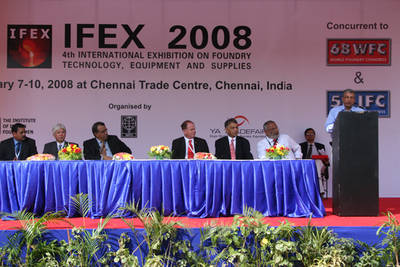Addressing foundrymen from across the country and the world at the valedictory sessions of the 68th Indian Foundry Congress and the 56th World Foundry Congress, Mr. Nayak, president of the machinery and industrial products division of Larsen and Toubro, said growth was bringing fresh challenges to the Indian foundry sector.
 While the industrial boom of the last three years had brought tremendous growth impetus, the fragmented nature of the sector meant that growth also highlighted the limitations of the sector.
While the industrial boom of the last three years had brought tremendous growth impetus, the fragmented nature of the sector meant that growth also highlighted the limitations of the sector.
80 per cent of foundries are small industries producing only 20 per cent of the industry’s total output of 7.5 million tonnes per year. These small players would not be able to access the investment, technology and training needed to modernise their foundries and exploit the growth opportunities unless they joined together and received help from industry associations, said Mr. Nayak.
According to V. Mahadevan, president of the Institute of Indian Foundrymen and managing director of Ennore Foundries, the challenge is that while the customers are very organised, the supply chain is not. Therefore, the challenge before it was to make huge investments to modernise the waste suppliers and help them comply with environmental requirements.
“The trend is clear. I expect to see a lot of consolidation in the next three to four years. Supply chain efficiencies must improve,” he said.
“The demand for casting, and tremendous opportunity associated with it, will put pressure on the casting sector. We have to invest in the future to reach 10 million tonnes in production of total castings. This calls for additional investment of $1 billion,” he said.
Small players catering to local markets will survive, said Mr. Mahadevan. However, the large scale original equipment manufacturers or OEMs will demand higher quality and efficiency than the SMEs can provide alone.
The industry association is trying to co-ordinate clusters to leverage cumulative volumes and effect energy efficiencies and training programmes as a group.
According to R. Seshasayee, Managing Director, Ashok Leyland, energy, and not water, would be the cause of future conflicts all over the world. Only a few countries had looked at energy costs as a competitive tool. The lack of a policy framework in India had affected those operating in the country. The Institute of Indian Foundrymen (IIF) should find ways and means of cutting energy costs.
“When you are handicapped, innovation takes place. The Indian foundry industry will find innovative methods to drastically cut energy costs. At the same time, input costs are going up, and there is a tremendous pressure on the casting sector to curtail it. We have to bring in technology for scrap recovery. The onus should be on the part of the waste generating industry and the foundry industry. There is a great opportunity for them to come together for organic recovery of waste material at affordable costs,” he said.
Energy efficiency was a key challenge for the future, both due to high power costs and rising environmental concerns. This would be reflected in the next World Foundry Congress to be held in China in 2010 with the theme, “Green Foundry”.
This year’s IFEX, the International Foundry Exhibition, have attracted over 9,000 visitors to the 210 stalls. Over 1600 delegates from 21 countries attended the dual congress.
Foundry-Planet was there | ||
<link internal-link> | Please visit our galleries |
|




 <link _top external-link-new-window>
<link _top external-link-new-window>
